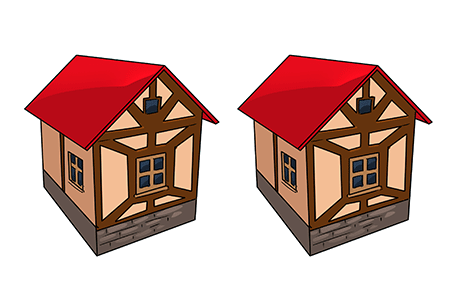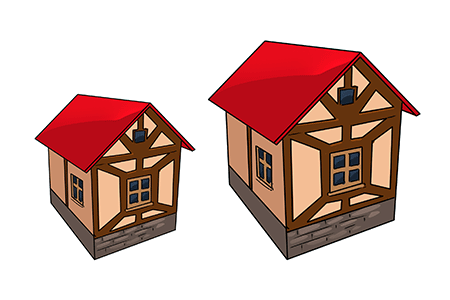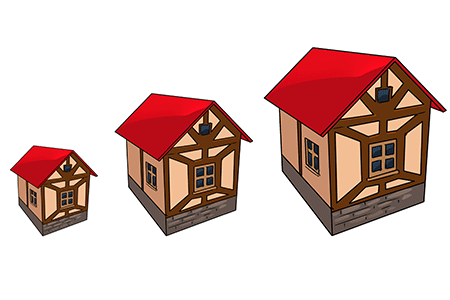Parts of speech and inflexion
Adjectives denote the qualities of persons, animals, objects and events.
They are classified into the following categories:
-
Qualitative
They can be compared (mladý , -mladší -najmladší )
mladý ,starý ,dobrý ,zlý ,pekný ,škaredý ,nový ,dlhý ,múdry -
Relational
They cannot be compared
drevený ,kamenný ,rybí ,psí -
Possessive
They cannot be compared
They are declined according to the paradigms {1} and {2}
otcov ,synov ,matkin ,sestrin ,dedov ,kolegov ,priateľkin
Declension of adjectives
Adjectives are always declined to agree with the nouns they describe.
-
ten pekný muž
The ending used for the masculine gender is -ý. -
tá pekná žena
The ending used for the feminine gender is -á. -
to pekné dieťa
The ending used for the neuter gender is -é.
Aký je dom? -Dom je vysoký. Aká je ruža? -Ruža je pekná. Aké je srdce? -Srdce je červené.
Note: In dictionaries, adjectives are traditionally written in the nominative singular masculine form (
Adjective declension models:pekný and cudzí
These two declensions are very similar. The difference is a soft ending used for the declension of
Singular
| Masculine | Feminine | Neuter | |
|---|---|---|---|
| N | |||
| G | |||
| D | |||
| A |
|
||
| L | |||
| I |
| Masculine | Feminine | Neuter | |
|---|---|---|---|
| N | |||
| G | |||
| D | |||
| A |
|
||
| L | |||
| I |
Plural
| Masculine (living) | Others | |
|---|---|---|
| N | ||
| G | ||
| D | ||
| A | ||
| L | ||
| I |
| Masculine (living) | Others | |
|---|---|---|
| N | ||
| G | ||
| D | ||
| A | ||
| L | ||
| I |
Model páví
The model of
Singular
| Masculine | Feminine | Neuter | |
|---|---|---|---|
| N | |||
| G | |||
| D | |||
| A |
|
||
| L | |||
| I |
Plural
| Masculine (living) | Others | |
|---|---|---|
| N | ||
| G | ||
| D | ||
| A | ||
| L | ||
| I |
Model words otcov and matkin
The declensions of
Singular
| Masculine | Feminine | Neuter | |
|---|---|---|---|
| N | |||
| G | |||
| D | |||
| A |
|
||
| L | |||
| I |
| Masculine | Feminine | Neuter | |
|---|---|---|---|
| N | |||
| G | |||
| D | |||
| A |
|
||
| L | |||
| I |
Plural
| Masculine (living) | Others | |
|---|---|---|
| N | ||
| G | ||
| D | ||
| A | ||
| L | ||
| I |
| Masculine (living) | Others | |
|---|---|---|
| N | ||
| G | ||
| D | ||
| A | ||
| L | ||
| I |
Singular (to je …)
| Masculine | Feminine | |
|---|---|---|
| ON | ||
| ONA | ||
| ONO |
Plural (to sú …)
| Masculine | Feminine | |
|---|---|---|
| ONI | ||
| ONY |
According to the model of
According to the model of
-
To je dom Lenky. =To je Lenkin dom.
Lenka is feminine, so it is declined likematkin -
To je žena kamaráta =To je kamarátova žena.
kamarát is masculine, so it is declined likeotcov -
To je auto brata =To je bratovo auto.
brat is masculine, so it is declined likeotcov
Comparison of adjectives and adverbs
Comparison can be regular or irregular. Irregular comparison is only used for the following five adjectives (and their derived adverbs):
All other adjectives and adverbs are compared regularly.
Regular comparison
The comparative degree of adjectives is formed using the ending -ší/-ejší?. The superlative degree is formed by adding the prefix naj- to the comparative degree.
| 1. degree |
easy
|
clever
|
|---|---|---|
| 2. degree |
easier
|
cleverer
|
| 3. degree |
easiest
|
cleverest
|
Adverbs are compared in the same way. The only difference is that for the comparative degree we use the ending -šie/-ejšie?. For the superlative degree we again add the prefix naj- to the comparative degree.
Irregular comparison
| 1. degree | 2. degree | 3. degree |
|---|---|---|
|
good / well
|
better / better (more well)
|
best / best (most well)
|
|
bad / badly
|
worse / worse (more badly)
|
worst / worst (most badly)
|
|
small / few/little
|
smaller / less
|
smallest / least
|
|
large / many/much
|
larger / more
|
largest / most
|
|
nice / nice
|
nicer / nicer
|
nicest / nicest
|
Comparison



-
1. degree
Jano je rovnako vysoký ako Lucka.
Jano a Lucka sú rovnako vysokí. -
2. degree
Jano je vyšší než Katka. -
3. degree
Jano je najvyšší z celej triedy.